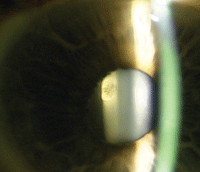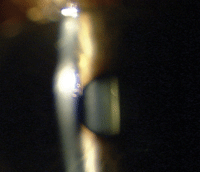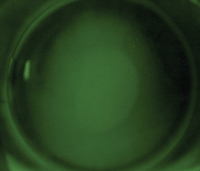 When considering the reasons for contact lens dropout, we can no longer blame a dearth of options. Significant improvements in contact lens technology—specifically, the advent of new materials designed to improve hydration—increase oxygen permeability and allow patients long-lasting comfort. Additionally, recent improvements in multifocal contact lens designs have created an opportunity to retain patients with presbyopia by correcting this frustrating visual deficit with contact lenses.
When considering the reasons for contact lens dropout, we can no longer blame a dearth of options. Significant improvements in contact lens technology—specifically, the advent of new materials designed to improve hydration—increase oxygen permeability and allow patients long-lasting comfort. Additionally, recent improvements in multifocal contact lens designs have created an opportunity to retain patients with presbyopia by correcting this frustrating visual deficit with contact lenses.
Lens materials have never been better and the visual performance of multifocal contact lens options has continued to improve, creating an opportunity for practice growth. And yet, presbyopia is precisely the point at which dropout becomes epidemic. Are you actively embracing all contact lens options to improve your presbyopic patients’ experience with contact lens wear?
Aside from such practice benefits, it is simply very rewarding to fit baby boomers with contact lenses. But to better manage presbyopic patients, eye care practitioners need to be more robust in their approach. In a survey of 500 patients with presbyopia, just 8% of current contact lens wearers reported being told about multifocal contact lenses when first complaining about their near vision.1 In addition, 33% of respondents indicated that they would likely seek the services of another practitioner if their current practitioner did not inform them of multifocal options.1
As an eye care professional, it is important to keep current on presbyopic contact lens choices to present patients’ options in a positive manner, while at the same time setting realistic vision expectations. For example, it’s critical to try to communicate presbyopic fitting in such a way as to avoid words with a negative connotation like “compromise” or “loss of vision.” Instead, describe multifocal lenses as “customized” or “balanced” according to each patient’s visual system.


1, 2. The Exam revealed bilateral posterior subcapsular cataracts (OD left, OS right).
If the patient needs readers to see the phone book or medicine bottles, let him or her know that this is normal and may be necessary. If you can eliminate a patient’s need for reading glasses 90% of the time, it is still a victory.
Case Report
DS, a 54-year-old white female, presented with complaints of blurred vision at both distance and near with her current contact lenses. Specifically, vision in her right eye tended to fluctuate more throughout the day than in her left. She considered discontinuing contact lens wear due to her loss of clear, crisp vision. At the time, she wore soft toric monovision contact lenses, with an average wear time of 8-10 hours.
Due to her growing visual and comfort symptoms, wear time had been steadily decreasing. DS, a teacher who used a computer for approximately 2-3 hours a day, complained of dry eye, discomfort and ocular fatigue with her current contact lenses. She also mentioned that her night driving had become increasingly difficult.
The patient’s medical history was positive for rheumatoid arthritis and osteopenia. She was being treated with an as-needed steroid shot, as well as calcium additives. Ocular history was positive for small posterior subcapsular cataracts (PSC), both OD and OS. She complained about these symptoms, reporting that she noticed that there was a further loss of crispness in her vision, specifically regarding night driving.
Her manifest refraction was:
OD: -4.50 -1.00 x 030 20/20
OS: -4.50 -1.50 x 005 20/20
Add +2.25 20/20 OU
DS had been wearing her current contact lenses for the past three years and enjoyed the freedom that contact lenses provided her vs. wearing spectacles.
Her contact lens Rx at presentation was:
OD: -4.25 -0.75 x 030
Distance = 20/25-2
Near = 20/50-
OS: -3.00 -1.25 x 180
Distance = 20/50
Near = 20/30
The patient’s keratometry readings were:
OD: 44.50 / 45.75 @ 097
OS: 44.75 / 46.75 @ 094
Slit-lamp exam revealed a small “off-center” PSC OU (see figures 1 and 2).
There are a plethora of viable contact lens modalities that might suit her needs, including: single vision soft toric (monovision or distance with over-readers), single vision RGP, single vision hybrid, multifocal soft toric, multifocal RGP and multifocal hybrid contact lenses. There are many varieties in each of these categories.

3. The patient's contact lens on-eye performance, showing proper centration and fit.
Doctor-Patient Decision
After reviewing her various contact lens options, DS was successfully fitted with hybrid multifocal contact lenses. Appropriate visual expectations were discussed thoroughly (i.e., that these lenses would allow her to have clear distance, intermediate and near vision for most visual tasks), as were the fees involved and the importance of follow-up care with her ahead of time. Other important aspects to convey to the patient were the basic principles of a simultaneous lens design and, as this was a custom-made lens, the expected time it would take for the fitting, fabrication, shipping and subsequent progress visits.
Simultaneous Vision Designs
Make sure to touch on the technology and explain to your patients that simultaneous vision designs deliver near, intermediate and distance correction simultaneously. These lenses offer a more gradual change between viewing zones vs. the “jump” between zones that comes with translating designs.
When beginning to fit a patient, err on the side of better distance vision, and inform the patient that the near vision performance will improve as the fitting process continues. This policy goes along with the golden rule of multifocal contact lens fitting: “If patients experience good distance vision initially, they will wear their lenses into their follow-up exam. If they don’t, they will carry them.”
The patient’s initial experience is critical step. Consider conducting a practical test at the dispensing visit (other than a visual acuity measurement) to determine a difference in functionality with the lenses. For example, ask patients to look at their cell phones, specifically directing them to let you know if they can see the numbers clearly. For smartphone users, ask if they can read an email. This demonstrates the “real-life” improvement in vision multifocal contact lenses can provide.
Conclusions
Both patients and practitioners have quite an array of available multifocal lens options (in soft, hybrid and gas permeable) to choose from. If we provide an individualized approach and take full advantage of current technologies, we have the ability to improve our presbyopic patients’ wearing experience while at the same time curtailing dropout.
This case demonstrates the importance of understanding the various multifocal designs and how to best “set the stage” with proper education and strategies for this demanding patient population. Keeping current on contact lens options for our presbyopic patients will help eye care professionals’ present multifocals in a positive light, while setting realistic vision expectations for patients. The time spent discussing contact lens options is a critical aspect in successfully fitting multifocals. Understanding patients’ hobbies, visual needs and real-world goals for their contact lenses will help best guide your fitting process.
1. Studebaker J. Soft multifocals: practice growth opportunity. Available at: www.clspectrum.com/article.aspx?article=103013 (Accessed July 2013).


